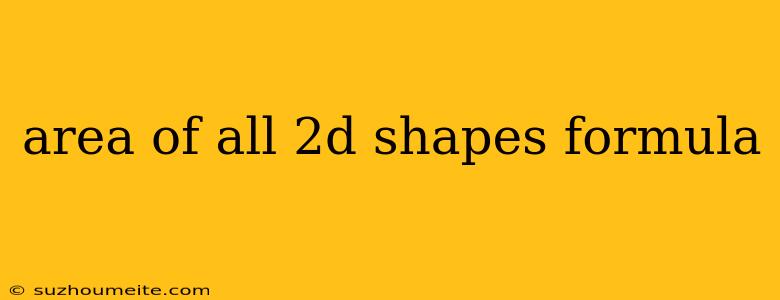Area of All 2D Shapes Formulas
This article will provide you with a comprehensive guide to calculating the area of all common 2D shapes.
Understanding Area
Area refers to the amount of space a two-dimensional figure occupies. It is measured in square units, such as square inches (in²) or square centimeters (cm²).
Formulas for Common 2D Shapes
Triangle
Formula: Area = (1/2) * base * height
Explanation:
- Base: Any side of the triangle can be chosen as the base.
- Height: The perpendicular distance from the base to the opposite vertex.
Square
Formula: Area = side * side
Explanation:
- Side: The length of any side of the square.
Rectangle
Formula: Area = length * width
Explanation:
- Length: The longer side of the rectangle.
- Width: The shorter side of the rectangle.
Parallelogram
Formula: Area = base * height
Explanation:
- Base: Any side of the parallelogram can be chosen as the base.
- Height: The perpendicular distance from the base to the opposite side.
Trapezoid
Formula: Area = (1/2) * (base1 + base2) * height
Explanation:
- Base1 and Base2: The two parallel sides of the trapezoid.
- Height: The perpendicular distance between the two bases.
Circle
Formula: Area = π * radius²
Explanation:
- π (pi): A mathematical constant approximately equal to 3.14159.
- Radius: The distance from the center of the circle to any point on its circumference.
Ellipse
Formula: Area = π * a * b
Explanation:
- π (pi): A mathematical constant approximately equal to 3.14159.
- a: Length of the semi-major axis (half the longest diameter).
- b: Length of the semi-minor axis (half the shortest diameter).
Regular Polygon
Formula: Area = (1/2) * perimeter * apothem
Explanation:
- Perimeter: The total length of all sides of the polygon.
- Apothem: The perpendicular distance from the center of the polygon to the midpoint of any side.
Remember
- Units are crucial! Ensure you include the appropriate square units when expressing the area of a shape.
- These formulas provide a solid foundation for calculating the area of various 2D shapes. However, specific variations or special cases might require adjustments or additional information.
By understanding these formulas and their applications, you can confidently calculate the area of any 2D shape you encounter.
